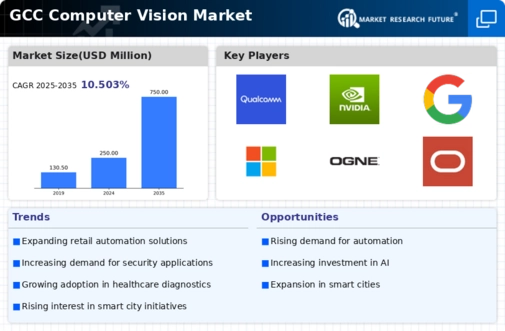Rising Demand for Automation
The push for automation across various sectors is significantly influencing the computer vision market. Industries such as manufacturing, logistics, and agriculture are increasingly adopting automated systems to enhance productivity and reduce operational costs. In the GCC, the automation market is expected to grow at a CAGR of 10% from 2025 to 2030, which suggests a robust demand for computer vision technologies that facilitate automation. These technologies enable machines to interpret visual data, allowing for tasks such as quality control, inventory management, and autonomous navigation. As businesses seek to streamline operations and improve efficiency, the reliance on computer vision solutions is anticipated to grow, thereby driving market growth in the region.
Technological Advancements in AI
The computer vision market is experiencing a surge due to rapid advancements in artificial intelligence (AI) technologies. These innovations enhance image processing capabilities, enabling more accurate and efficient analysis of visual data. In the GCC region, investments in AI are projected to reach $20 billion by 2030, indicating a strong commitment to integrating AI into various sectors. This integration is particularly evident in industries such as security, where AI-driven surveillance systems are becoming commonplace. The ability to analyze vast amounts of visual data in real-time is transforming operational efficiencies, thereby driving growth in the computer vision market. As organizations increasingly adopt AI technologies, the demand for sophisticated computer vision solutions is likely to escalate, further propelling market expansion.
Growing Focus on Security and Surveillance
The emphasis on security and surveillance in the GCC region is driving demand for computer vision technologies. With increasing concerns over safety, both public and private sectors are investing in advanced surveillance systems that leverage computer vision capabilities. The market for security cameras equipped with computer vision is projected to grow by 15% annually, reflecting a heightened focus on crime prevention and public safety. These systems can analyze video feeds in real-time, identifying potential threats and enabling quicker responses. As security needs evolve, the computer vision market is expected to expand, providing innovative solutions that enhance safety and security across various environments.
Increased Investment in Smart Infrastructure
The GCC region is witnessing substantial investments in smart infrastructure, which is a key driver for the computer vision market. Governments are prioritizing the development of smart cities, integrating advanced technologies to enhance urban living. For instance, the UAE has allocated $1.5 billion for smart city projects, which include the implementation of computer vision systems for traffic management and public safety. These systems utilize real-time data to optimize traffic flow and enhance security measures. As urban areas become more complex, the need for sophisticated computer vision solutions to monitor and manage these infrastructures is likely to increase, thereby fostering growth in the computer vision market.
Expansion of E-commerce and Retail Technologies
The rapid expansion of e-commerce in the GCC region is significantly impacting the computer vision market. As online shopping continues to grow, retailers are increasingly adopting computer vision technologies to enhance customer experiences and streamline operations. The e-commerce market in the GCC is projected to reach $28 billion by 2026, indicating a strong demand for innovative retail solutions. Computer vision applications, such as automated checkout systems and personalized shopping experiences, are becoming essential for retailers looking to remain competitive. This trend suggests that the computer vision market will continue to thrive as businesses seek to leverage technology to meet evolving consumer expectations.

















Leave a Comment